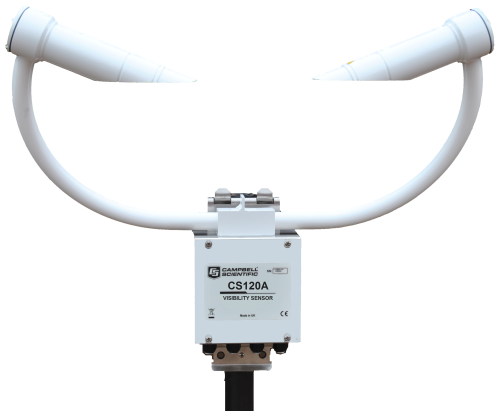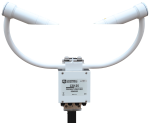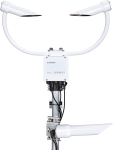






Resumen
El CS120A es un sensor de visibilidad por infrarrojos de dispersión frontal para uso autónomo o en una estación meteorológica automática, para aplicaciones en carreteras, marinas y aeropuertos. El CS120A utiliza la conocida técnica de dispersión frontal para determinar la visibilidad, utilizando un ángulo de dispersión de 42° que proporciona estimaciones precisas del Meteorological Observable Range (M.O.R.) para niebla y nieve.
Para aplicaciones aeronáuticas el CS120A cumple normativas CAA y ICAO; y también las CAP437, CAP670 y CAP746.
Certificado por el Deutscher Wetterdienst para controlar la luminosidad de las balizas luminosas en los aerogeneradores de parques eólicos, según norma 506/04, General Administrative Rules for the Identification of Aircraft Obstructions.
Leer másVentajas y características
- Sensor de alto rendimiento a precio competitivo
- Disponible extensión garantía de 3 años
- El diseño del sensor minimiza la interrupción del flujo de aire en el volumen de medición
- Incluye calentadores en cabezales (hood) y lentes (dew) para funcionamiento en todo tipo de condiciones meteorológicas
- Calibración en campo mediante kit de calibración opcional
- Bajo consumo - adecuado para aplicaciones remotas
- Sensor design minimizes airflow disruption at measurement volume
- Fabricado en UK
- Certificado para uso aeronáutico por el German Meteorological Service DWD
Imágenes



Descripción detallada
Comparado con sensores de otros fabricantes, el diseño del CS120A permite medir la visibilidad en un espacio relativamente limpio, porqué la posición de los cabezales y cuerpo del sensor minimizan la perturbación del flujo de aire en el volumen de medición.
El CS120A utiliza muestreo a alta velocidad continuo, que mejora la precisión de las medidas tomadas en condiciones de lluvia y granizo, y proporciona lecturas fiables durante situaciones más estables como niebla y neblina. El muestreo a alta velocidad también permite que el sensor responda mejor ante cambios repentinos de las condiciones meteorológicas.
El diseño característico del CS120A permite mantener limpias las ópticas. Las ópticas mirando hacia abajo minimizan la acumulación de suciedad y nieve. Los calentadores de bajo consumo (dew heaters) evitan la formación de escarcha, mientras que los calentadores de alto consumo (hood heaters) evitan la formación de hielo.
El sensor tiene un consumo muy eficiente, de tan sólo 3 W durante un funcionamiento normal con los calentadores contra escarcha (dew heaters) activos; se puede reducir el consumo posteriormente bajando la velocidad de muestreo y realizando el control manual de los calentadores.
Hay disponibles dos salidas de alarma mediante relés, que pueden activar sistemas de aviso externos como sirenas y semáforos. También se pueden utilizar, dependiendo de los niveles de visibilidad, para controlar la intensidad lumínica de las balizas luminosas en los aerogeneradores.
Especificaciones
| Signal Type/Output | RS-232, RS-485 |
| Measurement Description | Meteorological Observable Range (MOR) |
| Maximum Reported Visibility | 100 km (62.1 mi) |
| Minimum Reported Visibility | 5 m (16.4 ft) |
| Accuracy |
|
| Resolution | 1 m (3.3 ft) |
| Mounting | Stainless-steel V-bolt bracket that attaches to a pole with a 32 to 52.5 mm (1.25 to 2 in.) outer diameter |
| Electronics Supply Voltage | 7 to 30 Vdc |
| Total Unit Power | < 3 W while sampling continuously (including dew heaters) |
| Standards | Frangible masts are available to customer requirements to meet ICAO recommendations (typically placing the sample volume at 2.5 m [8.2 ft]). |
| Sensor Dimensions | 540 x 640 x 246 mm (21.26 x 25.2 x 9.7 in.) including mount |
| Sensor Weight | ~3 kg (6.6 lb) depending on mounting system |
Optical/Pulse |
|
| LED Center Wavelength | 850 nm |
| LED Spectral Bandwidth | ±35 nm |
| Light Pulse Rate | 1 kHz |
Environmental |
|
| Operating Temperature Range | -25° to +60°C (standard) |
| Extended Operating Temperature Range | -40° to +70°C (This extended version is available as a special. Contact Campbell Scientific for more information.) |
| Operating Humidity Range | 0 to 100% |
| Sensor Sealing | Rated to IP66 |
| Wind Speed | Up to 60 m s-1 |
| Sensor Heater Threshold |
|
DSP & Dew Heaters |
|
| Power | 2 x 0.6 W (total of 1.4 W) for dew heater |
| Typical Current Consumption @ 12 Vdc |
|
Hood Heater |
|
| Supply Voltage | 24 V dc or ac |
| Power | 2 x 30 W (total of 60 W) |
Interface |
|
| Serial Interface | RS-232 or RS-485, 8 bit data bytes, 1 stop bit |
| Serial Data Rates | 1200 to 115,200 bps (38,400 bps default rate) |
Documentos
Folletos producto
Manuales
Documentos técnicos
Casos de aplicación
Descargas
CR1000X CS120A example programs v.1 (2 KB) 18-03-2020
CR1000X programs that use the MSSET and MSGET commands.
CS125 and CS120A OS v.17 (555 KB) 08-06-2023
Campbell Scientific has introduced a new operating system, OS 17, for the CS120A visibility sensor and CS125 present weather sensor. It is backwards compatible and is easily installed on all CS120A and CS125 sensors (but not older CS120 sensors). OS 17 is available free of charge and can be downloaded here or supplied by email on request.
Upgrade to OS 17 is recommended.
Casos de aplicación
Exeter Airport is undergoing a huge refurbishment to expand their capabilities and streamline their operations......leer más
The Utah Department Of Transportation (UDOT) operates a network of roadside weather stations across the......leer más
AUDIMOBIL recently installed an Automatic Weather Station in a Portuguese Military Air Base, to support......leer más




